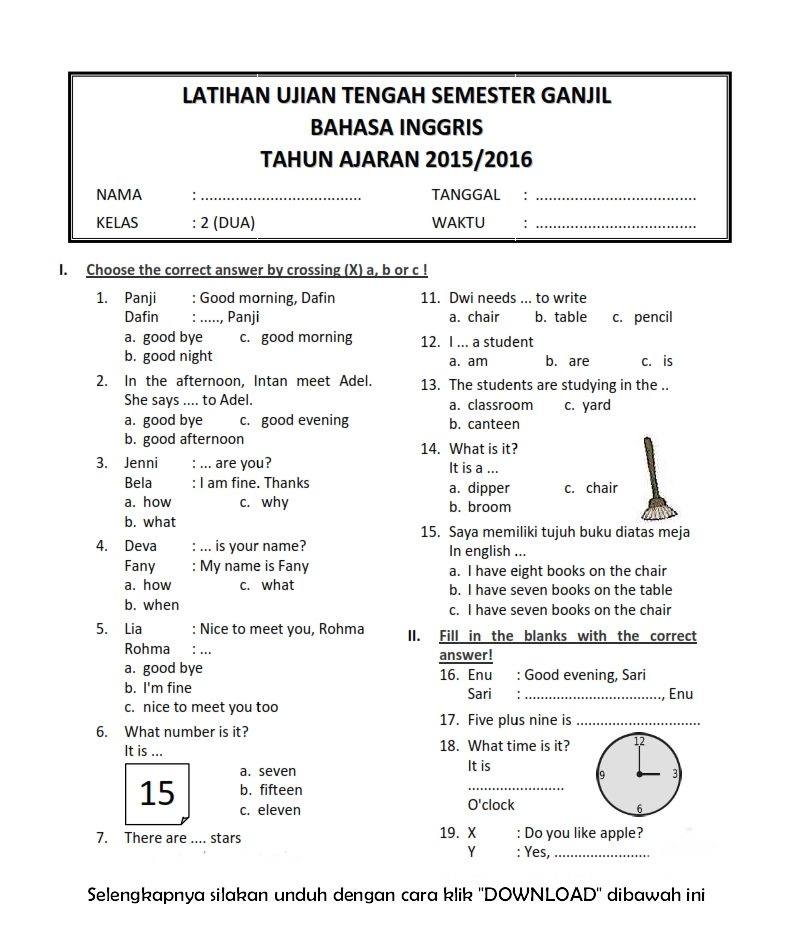
I. Introduction
A. Importance of English Language Learning in Grade 3
B. Scope of the Semester 2 Curriculum
C. Overview of the Example Questions
II. Vocabulary and Spelling
A. Matching words with pictures
B. Filling in the blanks with appropriate vocabulary
C. Spelling test (simple words related to daily life, animals, etc.)
III. Grammar
A. Simple Present Tense: Affirmative, Negative, Interrogative sentences.
B. Simple Past Tense: Regular and Irregular Verbs.
C. Plural Nouns: Regular and Irregular Plural forms.
D. Using "a," "an," and "the" correctly.
E. Basic Sentence Structure: Subject-Verb-Object.
IV. Reading Comprehension
A. Short story with comprehension questions (multiple choice and short answer)
B. Identifying main idea and supporting details.
C. Answering inferential questions based on the text.
V. Writing
A. Writing simple sentences about a picture.
B. Writing a short paragraph about a topic.
C. Writing a simple story.
VI. Listening Comprehension
A. Instructions followed based on simple audio instructions.
B. Answering questions based on a short audio clip.
C. Identifying keywords in a simple audio.
VII. Conclusion
A. Recap of the question types covered.
B. Importance of continuous practice.
C. Encouragement for further learning.
Example Questions for Grade 3 English Semester 2
I. Introduction
Learning English at a young age is crucial for developing strong communication skills and broadening future opportunities. The Grade 3 English curriculum for Semester 2 typically builds upon the foundation laid in Semester 1, focusing on expanding vocabulary, mastering fundamental grammar concepts, and improving reading and writing abilities. The following examples illustrate the types of questions students might encounter in a Semester 2 assessment.
II. Vocabulary and Spelling
A. Matching Words with Pictures:
Match the words in Column A with the correct pictures in Column B.
Column A Column B
- Sun (Picture of a sun)
- Tree (Picture of a tree)
- Flower (Picture of a flower)
- Bird (Picture of a bird)
- Car (Picture of a car)
B. Filling in the blanks with appropriate vocabulary:
Fill in the blanks with the correct words from the box.
(Box: big, small, happy, sad, run, jump)
- The elephant is a ___ animal.
- The mouse is a ___ animal.
- The girl is ___ because she got a new toy.
- The boy is ___ because he lost his ball.
- The children like to and .
C. Spelling Test:
Spell the following words correctly:
- cat
- dog
- house
- book
- sun
- tree
- bird
- flower
- car
- school
III. Grammar
A. Simple Present Tense:
- Affirmative: I (go) ___ to school every day.
- Negative: She (not play) ___ football.
- Interrogative: (Do) they (like) ice cream?
B. Simple Past Tense:
- Regular Verb: I (walk) ___ to the park yesterday.
- Irregular Verb: He (eat) ___ a sandwich for lunch.
- Complete the sentence: Yesterday, I ____ (go) to the zoo.
C. Plural Nouns:
- Write the plural form of: cat (____), dog (____), boy (____), child (____), bus (____).
- Write the plural form of: tooth (____), foot (____), woman (____), man (____), mouse (____).
D. Using "a," "an," and "the":
- I have ___ apple.
- She saw ___ elephant at the zoo.
- ___ sun is shining brightly.
- He plays ___ guitar.
- This is ___ best book I’ve ever read.
E. Basic Sentence Structure:
Rewrite the following words to form correct sentences:
- dog, the, barks.
- boy, the, ball, kicks, a.
- girl, sings, the, beautifully.
IV. Reading Comprehension
Read the following short story and answer the questions:
Once upon a time, there was a little girl named Lily who loved to play in the garden. She had a beautiful red dress and liked to chase butterflies. One sunny afternoon, she saw a big, colorful butterfly. She carefully followed it, and it led her to a hidden pond full of colorful flowers. Lily was very happy!
- What did Lily love to do?
- What color was Lily’s dress?
- What did Lily see in the garden?
- Where did the butterfly lead Lily?
- How did Lily feel at the end of the story?
V. Writing
A. Writing simple sentences about a picture: (Picture showing children playing in a park)
Write three sentences describing the picture.
B. Writing a short paragraph about a topic:
Write a short paragraph about your favorite animal.
C. Writing a simple story:
Write a short story about a cat and a mouse.
VI. Listening Comprehension
(These questions would require audio clips, which cannot be provided here. The questions would be designed to assess comprehension of simple instructions and short stories.)
A. Following Instructions:
(Audio instructions: "Clap your hands twice, then jump three times.")
B. Answering Questions based on a short audio clip:
(Audio clip: A short story about a dog.)
- What is the name of the dog?
- What color is the dog?
- What does the dog like to do?
C. Identifying keywords:
(Audio clip: A short weather report)
Identify three keywords from the weather report.
VII. Conclusion
The example questions above cover a range of skills crucial for Grade 3 English language proficiency. Consistent practice and engagement with diverse learning materials are essential for developing a strong understanding of vocabulary, grammar, reading, writing, and listening comprehension. Remember, the key to success is consistent effort and a positive attitude towards learning. Keep practicing and expanding your knowledge of the English language!